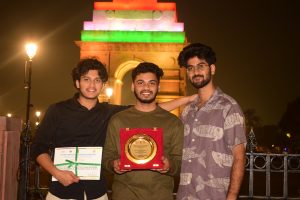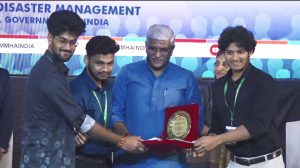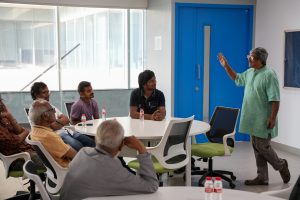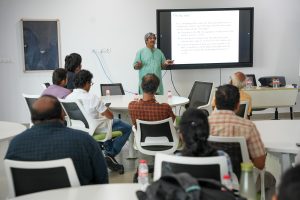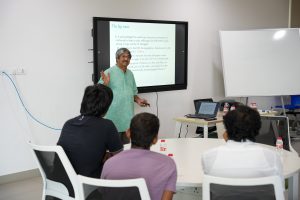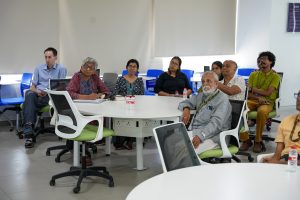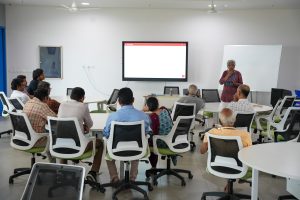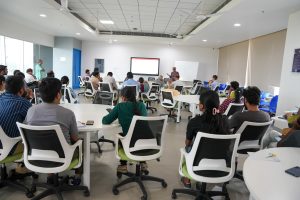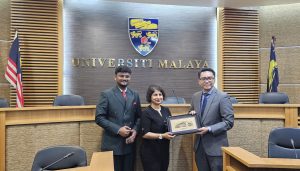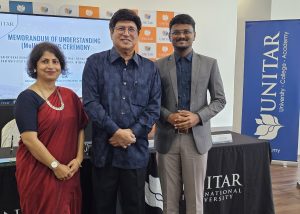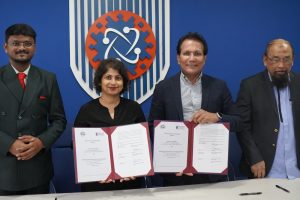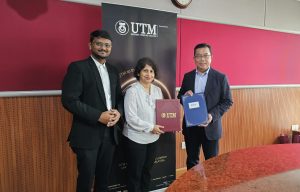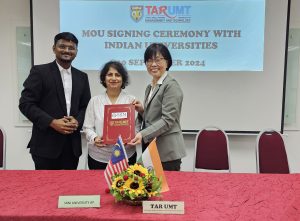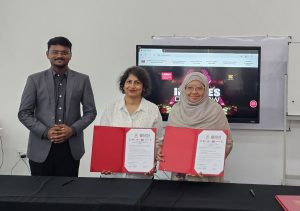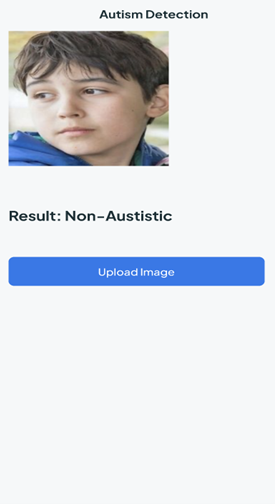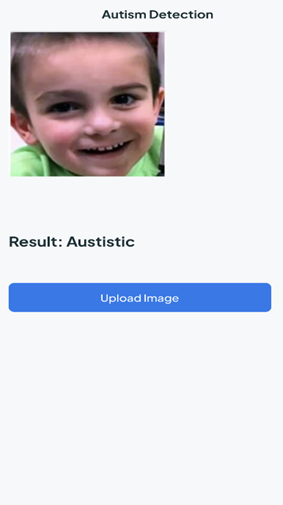FDP on Algebra, Analysis, and Number Theory Concluded Successfully
The Department of Mathematics at SRM University-AP hosted a successful Faculty Development Programme (FDP) on Algebra, Analysis, and Number Theory (AAN–2024) from December 16 to 20, 2024. This initiative aimed to strengthen faculty expertise in foundational mathematical disciplines essential for undergraduate (UG) and postgraduate (PG) education while also promoting effective teaching strategies.
Held online via Zoom, the programme attracted over 500 interested participants from across India, although due to platform capacity, 480 were accommodated. The FDP featured a series of keynote lectures by distinguished speakers focusing on core areas of mathematics.
Prof. V Kannan delivered an extensive session on analysis, discussing key theorems such as the Bolzano-Weierstrass theorem, the Intermediate Value Theorem, and the Heine-Borel theorem. The theoretical insights were complemented by tutorial sessions led by research scholars Mr Priti Prasanna Mondal and Ms Athulya P, who assisted participants in reinforcing their understanding through practical examples.
In the realm of number theory, Prof. Kalyan Chakraborty’s engaging lectures covered topics including plane curves, rational points, and elliptic curves, emphasising their importance and applications. Tutorial sessions by Dr Arkabrata Ghosh and research scholar Ms Leena Mondal supported these discussions with additional insights.
Dr Subha Sandeep Repaka presented comprehensive lectures on algebra, detailing concepts such as the structure of cyclic groups, Lagrange’s theorem, and Sylow’s theorems. These sessions were paired with tutorials that helped participants apply and solidify their knowledge.
Under the leadership of Convenor Dr Sandeep Kumar Verma and Co-Convenors Dr M Radhakrishnan and Dr G Damodar Reddy, the FDP offered valuable insights into advanced mathematical topics and innovative pedagogical approaches. Dr. Verma expressed gratitude for the overwhelming response, stating, “It was a privilege to organise this FDP, bringing together experts and participants to explore the depths of algebra, analysis, and number theory. This programme has served as a platform for knowledge exchange, fostering collaboration and growth in the field.”
The programme marked a significant step towards enhancing mathematics education and research, inspiring participants to incorporate new ideas and methodologies in their academic endeavours.
- Published in Departmental News, Math News, News
CINEMATES Team Clinches 2nd Prize in National Documentary Competition on Disaster Management
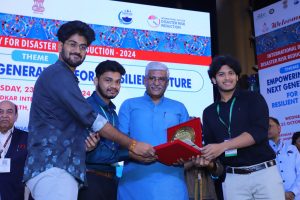 SRM University-AP is thrilled to announce that its talented CINEMATES team has secured the 2nd prize at the national level in the Documentary Competition on Disaster Management. This prestigious event was organised by the National Institute of Disaster Management (NIDM) under the Ministry of Home Affairs, Government of India, in celebration of the International Day for Disaster Risk Reduction 2024.
SRM University-AP is thrilled to announce that its talented CINEMATES team has secured the 2nd prize at the national level in the Documentary Competition on Disaster Management. This prestigious event was organised by the National Institute of Disaster Management (NIDM) under the Ministry of Home Affairs, Government of India, in celebration of the International Day for Disaster Risk Reduction 2024.
The competition centred on the theme “Empowering the Next Generation for a Resilient Future,” encouraging participants to explore innovative approaches to disaster management through their creative works. The CINEMATES team’s entry, a short film titled “After Shock,” stands out for its poignant narrative and compelling visuals that underscore the critical importance of disaster management education.
Written and directed by the brilliant student Shanmuka Shiva Durgesh Durvasula, “After Shock” delves into the harrowing experience of an earthquake through the contrasting perspectives of two individuals. The film masterfully portrays their survival instincts, shedding light on the emotional and psychological impact of such disasters. Noteworthy contributions in editing were made by Shaik Thaheer, Durgesh, and stunning cinematography by Siva Avula, all of which elevate the film’s powerful message.
In addition to the recognition, the team was awarded a cash prize of ₹1,50,000, a testament to their hard work and dedication. This achievement not only highlights the creative talents of SRM University-AP’s students but also reinforces the institution’s commitment to fostering a culture of awareness and resilience in disaster management.
As the university celebrates this remarkable accomplishment, it encourages all students to continue their journey toward making a meaningful difference in society through innovative thinking and responsible filmmaking.
- Published in Departmental News, News, student affairs news, Students Achievements
Prof. R Ramanujam Exploring the Role of Mathematics and Science in Social Inclusion
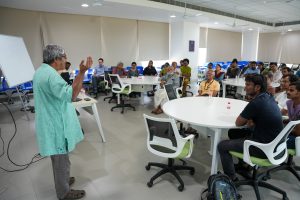 On October 4, 2024, Department of Mathematics at SRM University-AP hosted its 10th Distinguished Lecture, featuring renowned mathematician and educator Prof. R Ramanujam. The event attracted a diverse audience, including BSc and BTech students, PhD candidates, and faculty members, all eager to engage with the critical topic of mathematics and science education for students from socially and economically marginalised backgrounds.
On October 4, 2024, Department of Mathematics at SRM University-AP hosted its 10th Distinguished Lecture, featuring renowned mathematician and educator Prof. R Ramanujam. The event attracted a diverse audience, including BSc and BTech students, PhD candidates, and faculty members, all eager to engage with the critical topic of mathematics and science education for students from socially and economically marginalised backgrounds.
Prof. Ramanujam’s lecture posed a thought-provoking question: “What do mathematics and science education mean to a student from socially and economically marginalised sections?” Drawing from his extensive experience in various educational contexts, he provided valuable insights into the intersection of education and social equity. His work with the Tamil Nadu Science Forum, government curriculum bodies, and teacher education programs at Azim Premji University in Bengaluru informed his perspective on the necessity of aligning educational practices with the realities faced by marginalised communities.
During his talk, Prof. Ramanujam emphasised the importance of conducting educational research that is deeply rooted in social contexts. He argued that curriculum-making decisions should be informed by such research to ensure that education is socially inclusive and responsive to the unique challenges faced by disadvantaged students. His advocacy for an education system that addresses the needs of all learners resonated strongly with the audience, highlighting the potential for education to serve as a transformative force in society.
Prof. R Ramanujam is a distinguished figure in the fields of mathematics and education. He completed his PhD at the Tata Institute of Fundamental Research (TIFR) and pursued postdoctoral work at the City University of New York (CUNY), USA. His long-standing association with the Institute of Mathematical Sciences (IMSc) in Chennai and his current role as a visiting professor at Azim Premji University further underscore his commitment to advancing educational practices.
The lecture provided a stimulating exploration of how mathematics and science education can help address social inequalities. Prof. Ramanujam’s reflections on education, grounded in his experiences with marginalised communities, left a lasting impact on attendees. The event concluded with an engaging Q&A session, where participants raised questions about the challenges of implementing socially rooted educational reforms. This discussion reinforced the lecture’s key themes of inclusivity and the transformative potential of education when designed to meet the diverse needs of learners.
The 10th Distinguished Lecture at SRM University-AP not only highlighted the importance of educational equity but also inspired dialogue on how institutions can better serve all students, particularly those from marginalized backgrounds.
- Published in Departmental News, Math News, News
Pioneering IoT Security: Dr Mohammad Published in Prestigious Q1 Journal
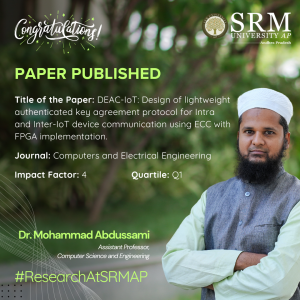 Dr Mohammad Abdussami, an Assistant Professor in the Department of Computer Science and Engineering, has made a significant contribution to the field of Internet of Things (IoT) security with the publication of his paper titled “APDEAC-IoT: Design of Lightweight Authenticated Key Agreement Protocol for Intra and Inter-IoT Device Communication Using ECC with FPGA Implementation.” This groundbreaking research has been published in the esteemed Q1 journal Computers and Electrical Engineering, which boasts an impact factor of 4.
Dr Mohammad Abdussami, an Assistant Professor in the Department of Computer Science and Engineering, has made a significant contribution to the field of Internet of Things (IoT) security with the publication of his paper titled “APDEAC-IoT: Design of Lightweight Authenticated Key Agreement Protocol for Intra and Inter-IoT Device Communication Using ECC with FPGA Implementation.” This groundbreaking research has been published in the esteemed Q1 journal Computers and Electrical Engineering, which boasts an impact factor of 4.
Dr Abdussami’s research addresses critical security challenges faced by IoT devices, particularly in facilitating secure communication between intra and inter-device networks. The lightweight authenticated key agreement protocol he has developed utilizes Elliptic Curve Cryptography (ECC) and Field-Programmable Gate Array (FPGA) implementation to enhance the security framework of IoT ecosystems.
As the adoption of IoT devices continues to expand across various sectors, the importance of robust security protocols cannot be overstated. Dr Abdussami’s work is poised to make a substantial impact on how devices communicate safely and efficiently, ensuring the integrity and confidentiality of data transmitted over the network.
As the demand for secure IoT solutions continues to grow, Dr Abdussami’s research stands as a beacon for future developments in this crucial area, potentially paving the way for safer and more efficient IoT interactions globally.
Abstract:
In this research work, we proposed a fog-enabled network architecture integrated with IoT devices (Intra and Inter-domain IoT devices) and developed the DEAC-IoT scheme using Elliptic Curve Cryptography (ECC) for secure authentication and key agreement. Our protocol is designed to protect device-to-device communication from security threats in resource-constrained IoT environments.
Citation format:
Abdussami Mohammad, Sanjeev Kumar Dwivedi, Taher Al-Shehari, P. Saravanan, Mohammed Kadrie, Taha Alfakih, Hussain Alsalman, and Ruhul Amin. “DEAC-IoT: Design of lightweight authenticated key agreement protocol for Intra and Inter-IoT device communication using ECC with FPGA implementation.” Computers and Electrical Engineering 120 (2024): 109696.
Explanation of the Research in Layperson’s Terms:
With more and more devices connecting wirelessly through the Internet of Things (IoT) (think of smart home gadgets, wearables, etc.), keeping their communications secure has become a big priority. However, many current communication methods for IoT devices don’t provide strong enough security. This leaves them open to cyber-attacks.
The challenge is to create a security system that is safe from attacks and doesn’t require too many computations. This is important because IoT devices often have limited resources (like low battery power or slower processors).
In this research, the authors have devised a solution: a new type of network setup (called fog-enabled architecture) that connects IoT devices with each other and with external devices. They’ve also developed a security protocol called DEAC-IoT, which uses Elliptic Curve Cryptography (ECC)—a highly efficient method for securing communications.
Their system makes it easier for IoT devices to authenticate (verify each other’s identity) and securely exchange keys (used to encrypt data), all while being lightweight enough to run on devices that don’t have a lot of processing power or energy.
In short: the paper offers a way to securely connect IoT devices with minimal computations, making communication between devices safe from hackers, even in environments where cyber threats are common.
Practical Implication and Social Implications Associated:
The practical implementation of this research can strengthen the security of IoT devices across many sectors, from homes and cities to healthcare and industries. The proposed DEAC-IoT scheme can also be used to implement vehicle to vehicle secure communication in autonomous vehicles, VANETs and Internet of Vehicles scenario.
Socially, it can enhance trust in IoT technology, protect privacy, safeguard critical infrastructure, and promote economic and technological development—while ensuring security remains affordable even in resource-constrained environments.
In Industrial IoT (IIoT) Scenario: In industries where machines are connected via IoT (such as in factories), devices need to communicate securely to ensure the smooth running of production lines. The DEAC-IoT protocol could secure these communications, preventing industrial espionage or sabotage.
Future Research Plans
1. Design of group key authentication protocols for IoT devices communication.
2. Design of handover authentication protocols for Fog-enabled IoT devices communication.
3. Design of quantum safe authentication protocols for vehicle-to-vehicle communication
Collaborations:
1. Dr Sanjeev Kumar Dwivedi, Centre of Artificial Intelligence, Madhav Institute of Technology and Science (MITS), Gwalior, Madhya Pradesh 474005, India.
2. Dr Taher Al-Shehari, Computer Skills, Department of Self-Development Skill, Common First Year Deanship, King Saud University, 11362, Riyadh, Saudi Arabia.
3. Dr Mohammed Kadrie, Computer Skills, Department of Self-Development Skill, Common First Year Deanship, King Saud University, 11362, Riyadh, Saudi Arabia
4. Dr P Saravanan, Department of Electronics and Communication Engineering, PSG College of Technology, Coimbatore, India.
5. Dr Ruhul Amin, Department of Computer Science & Engineering, IIIT Naya Raipur, Naya Raipur 493661, Chhattisgarh, India
6. Dr Taha Alfakih, Department of Information Systems, College of Computer and Information Sciences, King Saud University, Riyadh 11543, Saudi Arabia
7. Dr Hussain Alsalman, Department of Computer Science, College of Computer and Information Sciences, King Saud University, Riyadh 11543, Saudi Arabia
- Published in CSE NEWS, Departmental News, News, Research News
SRM AP Expands Horizons with India-Malaysia Academic Expedition
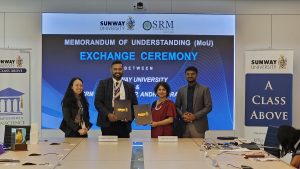 The Directorate of International Relations and Higher Studies (IR & HS), led by Dr Sudeshna Saha, Assistant Director and Sandeep Samala, Deputy Manager, embarked on a fruitful academic expedition tour to Kuala Lumpur from September 30 to October 3, 2024. This initiative aimed to foster collaboration between SRM University-AP and several prestigious Malaysian institutions.
The Directorate of International Relations and Higher Studies (IR & HS), led by Dr Sudeshna Saha, Assistant Director and Sandeep Samala, Deputy Manager, embarked on a fruitful academic expedition tour to Kuala Lumpur from September 30 to October 3, 2024. This initiative aimed to foster collaboration between SRM University-AP and several prestigious Malaysian institutions.
The primary objectives of the expedition were to explore collaborative opportunities, identify potential research partnerships, and promote matching grants that would mutually benefit the participating institutions.
During the expedition, a significant milestone was achieved with the signing of Memorandums of Understanding (MoUs) with several prominent Malaysian universities. Among them were the University of Malaya (#60 in QS World University Rankings 2025), Universiti Teknologi Malaysia (#181), Sunway University (#539), and Universiti Tunku Abdul Rahman (#800-#850). Additionally, collaborations were established with Malaysia University of Science and Technology (#88 in Asian University Rankings-Southeastern Asia 2024), Tunku Abdul Rahman University of Management and Technology (#139), University Malaysia of Computer Science & Engineering, and UNITAR International University.
The primary objectives of the visit were multi-faceted:
1. Exploring Collaborative Opportunities: The expedition aimed to identify and establish potential research collaborations between SRM University-AP and Malaysian institutions, fostering an environment conducive to joint academic exploration.
2. Promoting Matching Grants: The delegation sought to encourage initiatives such as matching grants that mutually benefit both institutions, enhancing research capabilities and funding opportunities.
3. Co-hosting Conferences: Plans were established to organise joint conferences, seminars, or workshops that facilitate the sharing of research findings and help build a robust academic network.
4. Collaborating on Scientific Projects: The institutions discussed initiating and supporting collaborative scientific research projects reflecting their combined strengths.
5. Focused Research Areas: Identifying key research areas for collaboration was paramount, with a commitment to connect with relevant Points of Contact (PIC) at the University of Malaya.
6. Joint Publications: The MoUs aim to foster partnerships for co-authored publications, thereby benefiting both institutions’ academic output.
7. Postgraduate Supervision: The institutions are committed to enhancing academic development by collaborating in the joint supervision of postgraduate students, emphasising PhD candidates.
8. Staff Mobility & Research Initiatives: A significant focus was placed on facilitating academic staff exchange programs to promote staff mobility and collaborative research initiatives.
9. Undergraduate Mobility Programs: Developing student mobility programs, including summer schools or student exchange opportunities, for undergraduates was a key part of the discussions.
The expedition successfully laid the groundwork for future collaborations, focusing on immersion programs, research internships, student and faculty mobility, and joint research initiatives.
As SRM University-AP continues to establish itself as a leader in higher education, this journey to Malaysia represents a commitment to nurturing global academic relationships and empowering the next generation of learners through collaborative endeavors.
- Published in Departmental News, International Relations, IR-News, News
Mr Ratna Raju Publishes Research on UAV-Assisted Service Caching
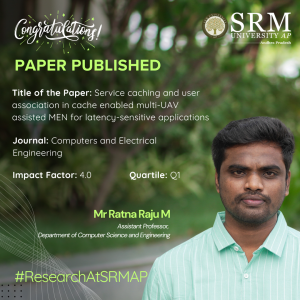 Mr M Ratna Raju, Assistant Professor in the Department of Computer Science and Engineering, has achieved a remarkable milestone by publishing a research paper titled “Service caching and user association in cache-enabled multi-UAV assisted MEN for latency-sensitive applications” in the esteemed Q1 journal, Computers and Electrical Engineering, which boasts an impact factor of 4.0.
Mr M Ratna Raju, Assistant Professor in the Department of Computer Science and Engineering, has achieved a remarkable milestone by publishing a research paper titled “Service caching and user association in cache-enabled multi-UAV assisted MEN for latency-sensitive applications” in the esteemed Q1 journal, Computers and Electrical Engineering, which boasts an impact factor of 4.0.
The paper explores innovative strategies for improving service caching and user association in multi-unmanned aerial vehicle (UAV) networks, addressing challenges faced by latency-sensitive applications. Mr Raju’s research contributes significantly to the field of computer science, particularly in enhancing the efficiency of UAV-assisted networks.
This publication not only highlights Mr Raju’s dedication to cutting-edge research but also reinforces SRM University-AP’s commitment to fostering academic excellence and innovation in technology. As the demand for efficient communication networks continues to grow, findings from this study are poised to play a critical role in shaping the future of network architecture and UAV applications.
The academic community and students alike look forward to Mr Raju’s further contributions as he continues to lead impactful research initiatives at SRM University-AP.
Abstract of the Research
The evolution of 5G (Fifth Generation) and B5G (Beyond 5G) wireless networks and edge IoT (Internet of Things) devices generates an enormous volume of data. The growth of mobile applications, such as augmented reality, virtual reality, network gaming, and self-driving cars, has increased demand for computation-intensive and latency-critical applications. However, these applications require high computation power and low communication latency, which hinders the large-scale adoption of these technologies in IoT devices due to their inherent low computation and low energy capabilities.
MEC (mobile edge computing) is a prominent solution that improves the quality of service by offloading the services near the users. Besides, in emergencies where network failure exists due to natural calamities, UAVs (Unmanned Aerial Vehicles) can be positioned to reinstate the networking ability by serving as flying base stations and edge servers for mobile edge networks. This article explores computation service caching in a multi-unmanned aerial vehicle-assisted MEC system. The limited resources at the UAV node induce added problems of assigning the existing restricted edge resources to satisfy the user requests and the associate of users to utilise the finite resources effectively. To address the above-mentioned problems, we formulate the service caching and user association problem by placing the diversified latency-critical services to maximise the time utility with the deadline and resource constraints.
The problem is formulated as an integer linear programming (ILP) problem for service placement in mobile edge networks. An approximation algorithm based on the rounding technique is designed to solve the formulated ILP problem. Moreover, a genetic algorithm is designed to address the larger instance of the problem. Simulation results indicate that the proposed service placement schemes considerably enhance the cache hit ratio, load on the cloud and time utility performance compared with existing mechanisms.
Explanation of the Research in Layperson’s Terms
The rapid growth of 5G (Fifth Generation) and B5G (Beyond 5G) wireless networks, along with edge IoT (Internet of Things) devices, is creating a massive amount of data. As mobile applications like augmented reality (AR), virtual reality (VR), online gaming, and self-driving cars become more popular, there’s a greater need for fast, powerful computing. However, IoT devices typically have limited computing power and energy, making it hard to run these advanced applications. Mobile Edge Computing (MEC) offers a solution to this problem by offloading tasks to servers located closer to users, reducing delays and improving performance.
In cases of emergency where network failure occurs due to natural disasters, Unmanned Aerial Vehicles (UAVs) can be used to restore connectivity. UAVs can act as flying base stations and edge servers, helping mobile edge networks continue functioning. This research focuses on improving how computation services are cached and handled in a system that uses multiple UAVs to assist MEC. Since UAVs have limited resources, there’s a challenge in efficiently assigning these resources to meet user demands. The research proposes a solution by formulating this problem as an integer linear programming (ILP) problem, aiming to place services in a way that maximises performance while considering deadlines and resource limits. To solve this complex issue, we use two approaches. First, they apply an approximation algorithm based on a rounding technique to solve the ILP problem. Then, for larger problems, they use a genetic algorithm. Their simulation results show that these service placement strategies significantly improve metrics like cache hit ratio, load reduction on the cloud, and time utility, compared to existing methods.
Practical Implementation and the Social Implications Associated
The practical implementation of this research lies in enhancing the efficiency of real-time, computation-intensive applications like augmented reality (AR), virtual reality (VR), autonomous driving, and network gaming in mobile edge computing (MEC) environments, particularly in scenarios involving Unmanned Aerial Vehicles (UAVs). By optimizing how services are cached and distributed in a multi-UAV-assisted MEC system, the research enables faster data processing and lower latency, which is crucial for applications where even slight delays can cause major issues, such as in self-driving cars or real-time remote surgeries. In emergency situations, such as natural disasters, where ground-based networks may be damaged or overloaded, the deployment of UAVs as flying base stations and edge servers could restore network connectivity quickly and provide essential services. This research ensures that even under such constraints, services are efficiently distributed, enhancing responsiveness and reliability.
Social Implications:
Disaster Relief: UAVs with MEC support could be deployed during natural calamities to restore communication services, helping rescue teams coordinate better and saving lives.
Smart Cities and Autonomous Vehicles: The work contributes to making smart cities more responsive, with real-time data processing and seamless service delivery. Autonomous vehicles, for instance, would benefit from reduced latency, leading to safer and more efficient navigation.
Healthcare: Applications such as telemedicine and remote surgery could operate more effectively with lower latency, improving healthcare delivery in remote or disaster-affected regions.
Collaborations
1. Manoj Kumar Somesula and Banalaxmi Brahma from Dr. B. R. Ambedkar National Institute of Technology Jalandhar, Punjab 144008, India.
2. Mallikarjun Reddy Dorsala from Indian Institute of Information Technology Sri City, Chittoor, Andhra Pradesh 517646, India.
3. Sai Krishna Mothku from National Institute of Technology, Tiruchirappalli 620015, India
Future Research Plans
In future, we plan to consider the unique challenge of making caching decisions while accounting for the limited energy capacity of UAVs, mobility of UAVs, network resources, and service dependencies, which introduces new complexities in algorithm design minimising the overall service delay while adhering to constraints such as energy consumption, UAV mobility, and network resources. This would require the joint optimisation of service caching placement, UAV trajectory, UE-UAV association, and task offloading.
- Published in CSE NEWS, Departmental News, News, Research News
Breakthrough in Autism Detection: A New System Patent by CSE Researchers
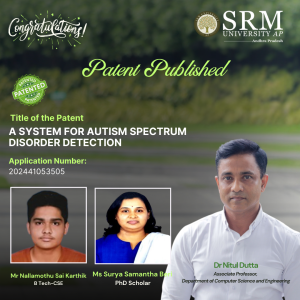 In a significant advancement for neurodevelopmental research, Dr Nitul Dutta, Associate Professor in the Department of Computer Science and Engineering, along with PhD scholar Ms Surya Samantha Beri and BTech student Mr Nallamothu Sai Karthik, have successfully filed and published a patent titled “A System for Autism Spectrum Disorder Detection.” The application, numbered 202441053505, has been officially documented in the Patent Office Journal.
In a significant advancement for neurodevelopmental research, Dr Nitul Dutta, Associate Professor in the Department of Computer Science and Engineering, along with PhD scholar Ms Surya Samantha Beri and BTech student Mr Nallamothu Sai Karthik, have successfully filed and published a patent titled “A System for Autism Spectrum Disorder Detection.” The application, numbered 202441053505, has been officially documented in the Patent Office Journal.
The innovative system aims to enhance the early detection of Autism Spectrum Disorder (ASD), providing a more efficient and accessible method for diagnosis. By integrating advanced algorithms and machine learning techniques, the system promises to analyse behavioural data effectively, allowing for timely interventions and support for individuals on the spectrum. Dr Dutta emphasised the importance of early detection, stating, “The earlier we can identify ASD, the better the outcomes for individuals and their families. Our system is designed to make this process more accurate and user-friendly.”
Ms Beri and Mr Karthik contributed significantly to the research, which reflects a collaborative effort between academia and technology. Their work not only demonstrates the potential for technological solutions in healthcare but also highlights the critical role of interdisciplinary approaches in addressing complex challenges.
This patent represents a crucial step forward in the field of autism research and is expected to pave the way for further innovations aimed at improving the lives of those affected by ASD.
Abstract of the Research
The system for autism spectrum disease detection incorporates a server with a hybrid application comprising several key modules: a capturing module receiving images from image-capturing devices , a data collection module gathering a dataset of images from multiple capturing devices, and a pre-processing module standardising and normalising images to generate a standardised dataset. Additionally, a feature extraction module collaborates with the pre-processing module to identify autism-indicative features in standardised images, preparing labelled standardised images stored in the data collection module.
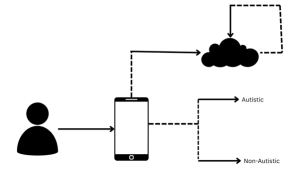
Furthermore, a data segmentation module segments standardised images into training and testing data, including a training module for real-time training of a convolutional neural network model and a testing module to evaluate the convolutional neural network model’s accuracy in detecting autism based on testing data.
Explanation of the Research in Layperson’s Terms
The background information herein below relates to the present disclosure but is not necessarily prior art. Autism spectrum disorder (ASD) is a neurological or developmental disorder that profoundly impacts communication skills, social interaction, and cognitive abilities in individuals. Those with Autism Spectrum Disorder (ASD) often exhibit challenges in social interaction, limited eye contact, difficulty understanding social cues, and impaired language skills. Additionally, repetitive behaviours and sensory sensitivities are common characteristics.
The disorder arises from developmental changes in brain structure and can have various causes, including genetic factors, familial history of autism spectrum disorder (ASD), advanced parental age, or low birth weight. The prevalence of autism spectrum disorder (ASD), as reported by the World Health Organization (WHO), stands at one in every 160 children. Early detection and intervention are crucial for managing autism spectrum disorder (ASD) effectively, as interventions such as medical and neurological examinations, cognitive and language assessments, and frequent observations, including blood and hearing tests, can significantly improve outcomes. Detecting Autism Spectrum Disorder (ASD) in children below the age of 10 is comparatively easier than in adults, underscoring the importance of early diagnosis to facilitate timely interventions.

Current diagnostic processes for autism spectrum disorder (ASD) often present significant challenges, particularly for young children, due to their limited ability to communicate and cooperate during assessments. Traditional diagnostic methods rely heavily on structured interviews, behavioural observations, and standardised tests, which can be daunting and stressful for children, leading to inaccurate results. Moreover, these procedures are time-consuming and often require multiple visits to specialised clinics or healthcare facilities, causing inconvenience and financial strain for families. Also, the cost associated with autism spectrum disorder (ASD) diagnosis can be prohibitive for many families.
Therefore, there is a pressing need for more accessible, less intrusive, and cost-effective methods for detecting autism spectrum disorder (ASD) in its early stages to ensure timely and effective intervention. Therefore, there is a need for a system for autism spectrum disorder detection that alleviates the drawbacks.
Practical and Social Implications Associated with the Research
Current diagnostic procedures for Autism Spectrum Disorder (ASD) face considerable technical challenges, particularly concerning young children’s limited ability to engage in conventional assessment methods. These methods typically rely on structured interviews, behavioural observations, and standardised tests, all of which can be arduous and distressing for children with Autism Spectrum Disorder (ASD), potentially leading to unreliable outcomes. Furthermore, these procedures are resource-intensive, requiring multiple visits to specialised clinics or healthcare facilities, thereby causing logistical challenges and financial burdens for families. Current diagnostic processes for Autism Spectrum Disorder (ASD) often present significant challenges, particularly for young children, due to their limited ability to communicate and cooperate during assessments. Traditional diagnostic methods rely heavily on structured interviews, behavioural observations, and standardised tests, which can be daunting and stressful for children, leading to inaccurate results. Moreover, these procedures are time-consuming and often require multiple visits to specialised clinics or healthcare facilities, causing inconvenience and financial strain for families. Also, the cost associated with Autism Spectrum Disorder (ASD) diagnosis can be prohibitive for many families. Therefore, there is a pressing need for more accessible, less intrusive, and cost-effective methods for detecting Autism Spectrum Disorder (ASD) in its early stages to ensure timely and effective intervention.
Collaborations
This research was done in collaboration with Professor George, Brunel University, London, United Kingdom
Future Research Plans
In the future, we will also try to diagnose the disorder by speech therapy using Natural Language Processing and integrate it with real-time industry in health care, which can be used by many doctors in their respective practices
- Published in CSE NEWS, Departmental News, News, Research News
Patent Filed for Innovative Load Balancing System in Cloud Computing
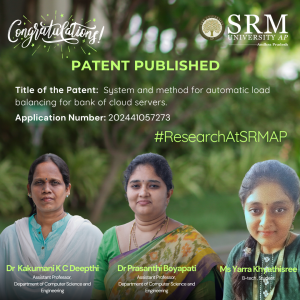 In a significant advancement for cloud computing technologies, Dr Kakumani K C Deepthi and Dr Prasanthi Boyapati, Assistant Professors in the Department of Computer Science and Engineering, alongside B Tech student Ms Yarra Khyathisree, have successfully filed and published a patent titled “SYSTEM AND METHOD FOR AUTOMATIC LOAD BALANCING FOR BANK OF CLOUD SERVERS.” The patent, registered with Application Number 202441057273, was officially published in the Patent Office Journal.
In a significant advancement for cloud computing technologies, Dr Kakumani K C Deepthi and Dr Prasanthi Boyapati, Assistant Professors in the Department of Computer Science and Engineering, alongside B Tech student Ms Yarra Khyathisree, have successfully filed and published a patent titled “SYSTEM AND METHOD FOR AUTOMATIC LOAD BALANCING FOR BANK OF CLOUD SERVERS.” The patent, registered with Application Number 202441057273, was officially published in the Patent Office Journal.
As cloud computing continues to expand, effective load balancing has become critical for optimizing distributed environments. Load balancing is essential for distributing data and services across a scalable network of nodes, ensuring that no single node becomes overwhelmed. This is particularly important as data storage needs in cloud environments grow exponentially.
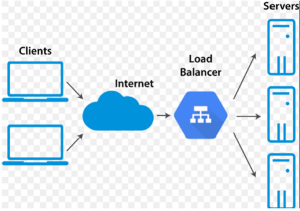
The newly patented system aims to enhance load balancing and job scheduling, addressing the increasing demand for efficient services. The article highlights various notification algorithms designed to improve these processes, comparing the latest methods to boost performance and user satisfaction.
This innovation marks a promising step forward in cloud computing technology, paving the way for more robust and efficient systems to meet the evolving needs of users and organizations alike.
Abstract of the Research
Load balancing is crucial for the efficient operation of distributed environments, especially with the rapid growth of cloud computing and increasing customer demands for more services and positive outcomes. Cloud load balancing involves transparently sharing data and delivering services through a scalable network of nodes. Due to the open and distributed nature of cloud computing, the amount of data storage grows rapidly, making load balancing a critical issue. Managing load information in such a vast system is costly. A major challenge in cloud computing is distributing dynamic workloads across multiple nodes to prevent any single node from becoming overwhelmed. Numerous algorithms have been proposed to effectively allocate customer requests to available cloud nodes. These methods aim to enhance the overall performance of the cloud and provide users with more satisfying and efficient services. This article reviews various notification algorithms to address cloud computing load balancing and job scheduling issues, comparing the latest methods in the field.
Practical Implementation or the Social Implications Associated with the Research
In this patent, the common load-balancing algorithms in cloud computing include:
• Round Robin
• Least Connection
• Randomized
• Load Balancing Challenges in Cloud Computing
• Automated Service Provisioning
• Virtual Machine Migration
• Energy Management
• Stored Data Management
Future Research Plans
To implement automatic load balancing for not only banks but also some other applications where cloud servers can be designed by ensuring optimal resource utilization, performance, and reliability.
- Published in CSE NEWS, Departmental News, News, Research News
B Tech Students Pave the Path for Future Entrepreneurs with Vascan Solutions
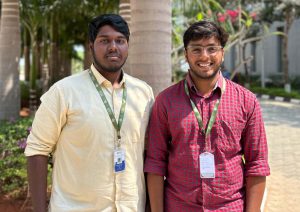 SRM University-AP is honoured to recognise the impressive accomplishments of B Tech CSE third-year students Sai Tharun Nelluru and Mahendra Kumar Velicheti, co-founders of Vascan Solutions, a startup aiming to disrupt the retail space. This is especially so when one considers that the decision to venture into entrepreneurship entails taking risks that the norm would prescribe against – seeking employment graduates.
SRM University-AP is honoured to recognise the impressive accomplishments of B Tech CSE third-year students Sai Tharun Nelluru and Mahendra Kumar Velicheti, co-founders of Vascan Solutions, a startup aiming to disrupt the retail space. This is especially so when one considers that the decision to venture into entrepreneurship entails taking risks that the norm would prescribe against – seeking employment graduates.
Vascan Solutions, as a company, is a clear Shiff economics and architecture in Context business solving real problems in the business of retailing. Understanding the pain points that exist for both shoppers and retailers, Sai Tharun and Mahendra created a mobile app intending to improve retailing activity. Shoppers can search for items, navigate inside the store accurately and use their phones to pay for items. This improves the ease of shopping for customers. On the one hand, retailers get valuable information from consumers about what they choose and how often they come. With this information, it is easy for marketers to reorganise the store improve customer service and increase sales.
The creation of Vascan Solutions is a testament to the vision and commitment of SRM AP students. However, their success story also highlights the importance of mentorship, an integral aspect of SRM AP’s entrepreneurial ecosystem. Sai Tharun and Mahendra were guided by Dr Shobin CC and Dr Randhir Singh, who provided technical expertise that helped refine their product and strategy. Additionally, Mr Siddharth Shankar Tripathy, Director of Entrepreneurship & Innovation, SRM University-AP, played a pivotal role in mentoring the co-founders, offering them the support needed to navigate the complexities of launching a startup.
SRM University-AP’s commitment to fostering entrepreneurship is evident in the success of Vascan Solutions. The university takes pride in cultivating an environment where students are encouraged to think creatively, innovate, and challenge the status quo. Sai Tharun and Mahendra’s decision to build their own business demonstrates the transformative potential of this environment. Their entrepreneurial journey serves as an inspiration not only to their peers but also to future generations of students who wish to explore non-traditional career paths and make a meaningful impact on society.
The establishment of Vascan Solutions aligns with SRM AP’s vision of empowering students to become leaders and innovators. The university strongly believes that entrepreneurship is not only a viable career option but also a path that can contribute to societal and economic development. Sai Tharun and Mahendra have proven that with determination, innovation, and the right mentorship, young entrepreneurs can turn challenges into opportunities.
Looking ahead, SRM University-AP is excited to see the continued growth of Vascan Solutions. With a solid foundation and a clear vision, the startup has the potential to scale and expand beyond the retail sector, further solidifying the impact of Sai Tharun and Mahendra’s contributions. As Vascan Solutions evolves, SRM AP remains committed to supporting entrepreneurial initiatives that empower students to become changemakers in their respective fields.
- Published in CSE NEWS, Departmental News, IDEA NEWS, News
Dr Jaidev Advances Green Chemistry with New Acetic Acid Production Technique
 In a remarkable contribution to the field of green chemistry, Dr Jaidev Kaushik, Assistant Professor in the Department of Chemistry, has published a significant research paper titled “Green Light Promoted Photoreduction of Carbonate to Acetic Acid by Zinc Ash-Derived ZCu@ZnO” in the prestigious Q1 journal, ACS Sustainable Chemistry & Engineering, with an impressive impact factor of 7.1.
In a remarkable contribution to the field of green chemistry, Dr Jaidev Kaushik, Assistant Professor in the Department of Chemistry, has published a significant research paper titled “Green Light Promoted Photoreduction of Carbonate to Acetic Acid by Zinc Ash-Derived ZCu@ZnO” in the prestigious Q1 journal, ACS Sustainable Chemistry & Engineering, with an impressive impact factor of 7.1.
Dr Kaushik’s research addresses the pressing need for sustainable methods of producing acetic acid, a widely used chemical in various industrial applications. The study explores an innovative photoreduction process that utilises green light to convert carbonate compounds into acetic acid using a novel catalyst derived from zinc ash. This approach not only showcases the potential for an eco-friendly production method but also emphasises the recycling of zinc waste, turning a byproduct into a valuable resource.

The paper highlights the efficiency of Zinc Ash-Derived ZCu@ZnO as a catalyst in the photoreduction process, demonstrating its effectiveness under green light conditions. The findings could pave the way for more sustainable practices in chemical manufacturing, aligning with global efforts to reduce carbon emissions and promote environmentally friendly technologies.
This publication underscores the commitment of SRM University – AP to fostering innovative research that addresses contemporary environmental challenges. Dr. Kaushik’s work exemplifies the university’s focus on sustainability and its aspiration to lead in the field of scientific research.
As the demand for sustainable chemical processes grows, Dr Kaushik’s research will likely inspire further investigations and developments in green chemistry, contributing to a more sustainable future.
Abstract of the Research
Mineralized carbon (carbonate) is the readily available carbon dioxide (CO2) source in acidic aqueous conditions. The photoreduction of carbonate to value-added hydrocarbons could be a novel finding performed in the presence of monochromatic visible light and waste-derived photo-active nanomaterials. In this report, we have synthesized ZnO particles from the zinc ash generated as waste in the galvanization process in the steel industry; ZnO particles were decorated with CuO nanoparticles and then further activated by reducing them to get a heterojunction photocatalyst (ZCu@ZnO). After that, ZCu@ZnO is utilized to photoreduce carbonate to acetic acid (AcOH) in a peroxy-rich solvent as a hydrogen-rich solvent under various monochromatic light sources and sunlight. Additionally, different physical and chemical parameters, such as solvent mixture, light sources, photocatalysts, time, etc., were optimized to get the maximum yield of AcOH under monochromatic light of 525 nm wavelength (Green light).
Explanation of the Research in Layperson’s Terms
This report is proposing the solution of two problem statements; first, utilization of zinc ash generated as a by-product after galvanization process; and second, cost-effective and energy efficient process for conversion of carbonates to value-added C2 hydrocarbon.
Practical Implementation and the Social Implications associated with the Research
The process adds value by converting low-value waste into high-value nanomaterials, potentially offering new revenue streams for recycling and waste management industries. It supports the principles of a circular carbon economy and green chemistry focusing on synthesis of hydrocarbons from carbonates.
Collaboration
Dr Sumit Kumar Sonkar (MNIT Jaipur, India)
Future Research Plans
1. The adsorption/photodegradation-assisted quick and efficient removal of next generation advanced pollutants such as microplastic, pesticides, pharmaceutical waste, etc. by hydrophobic carbon aerogel and their doped and functionalized versions.
2. Utilizing waste derived heterogeneous catalysts in organic transformation reactions.
3. Selective sensing of toxic metal ions/biomarkers/biomolecules using fluorescent nanomaterials.
4. Upcycling of carbonates/CO2 via photo/thermal assisted catalyzed reactions to get C1 and C2 hydrocarbons (green fuel).
- Published in Chemistry-news, Departmental News, News, Research News


